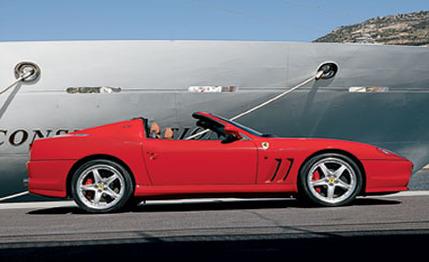
 First Drive Review
First Drive Review
Ferrari brought the world's press to the posh principality of Monaco to properly show off its latest creation in rapid, open-air transport, the Superamerica. The Côte d'Azur offers a great combination of a sunny, convertible-friendly climate, high-speed autoroutes, and twisty two-lane mountain roads for wringing out a grand tourer. Monaco is also home to more than 400 Ferraris, not bad for a country that is about the size of Central Park.
The Superamerica moniker comes from a Ferrari tradition of giving special names to limited-edition models. From 1951 to 1960, Ferrari built 62 custom-bodied cars called Americas and Superamericas. The Super prefix identified cars with modified, more powerful engines. Today's Superamerica convertible is derived from the 575M Maranello hardtop coupe that Ferrari introduced three years ago. The 575M coupe is one of the world's great grand-touring cars. It combines power, speed, and comfort with a classically styled long-nose, short-rear-deck body. The 575M is the perfect instrument for cruising long distances quickly and comfortably, your own two-seat land jet for that long road to the sea.
But after winging your way to your favorite sun-drenched coast, wouldn't it be fun to enjoy all the rays? The Superamerica lets you do just that by literally flipping its lid. The glass roof panel rotates backward on the axis of its rear edge and comes to rest flush on top of the trunklid. There is no origami-style folding and turning like the convertible roof on a Mercedes-just a simple up and over. Also unlike a Benz, since the roof comes to rest on top of the trunklid, the interior volume of the trunk doesn't decrease. The Superamerica has the same eight-cubic-foot capacity as the 575M coupe. The rear window stays in place and with the roof open works as a wind blocker. All the driver has to do is release a catch on the windshield header and hit a switch on the center console. The entire operation, up or down, takes about 10 seconds. Ferrari calls the glass roof Revocromico: It revolves, and the amount of tinting in the panel is variable. The glass has sheets of electrochromic film layered in it that alter their transparency according to the amount of electrical current running through them. A knob on the center console allows for five different levels of light transmission, from an almost clear light blue to a very dark blue. It takes just 60 seconds to go from the lightest to darkest setting, and even at the darkest setting the panel is not completely opaque-you can always see the sun through it.
The Superamerica is based on the 575M coupe's chassis, and to maintain body rigidity with the roof open, the side sills, the center chassis tunnel, and the A-pillars have been reinforced. Rear buttresses were also added, and the rear bulkhead and transaxle area were strengthened and braced. The 575M's computer-controlled suspension is standard on the Superamerica. It has two modes, comfort and sport. The computer uses signals from six accelerometers to read the road surface and adjusts the shocks to maximize ride or handling. With the top up, the Superamerica has the smooth ride and sporty handling of the 575M. With the top down, we did sense a little body quiver over large irregularities, but the car's road manners didn't feel compromised.
The convertible top isn't the only thing different about the Superamerica. To justify the use of the Super prefix, Ferrari bumped up the horsepower of the 575M's 5.7-liter V-12 from 508 to 532 by increasing the flow rate of the intake tracts and fitting the car with a new exhaust system with less back pressure. The torque figure is unchanged at 434 pound-feet. Two different transmissions can be mated to this beast of an engine: a standard six-speed manual or an F1-style paddle-shift six-speed with a computer-controlled clutch. With the F1 gearbox, performance should be about the same as that of the last 575M we tested, which went 0 to 60 mph in 4.2 seconds. Ferrari says the convertible weighs 200 more pounds than the coupe.
With a paddle-shifting tranny, a Superamerica will set you back about $315,000. The base six-speed is $305,000. Sad to say, the allotment of 170 cars for the U.S. has already been spoken for. So if you are one of the lucky ones, flip your lid, put your right foot to the floor, and enjoy the music.